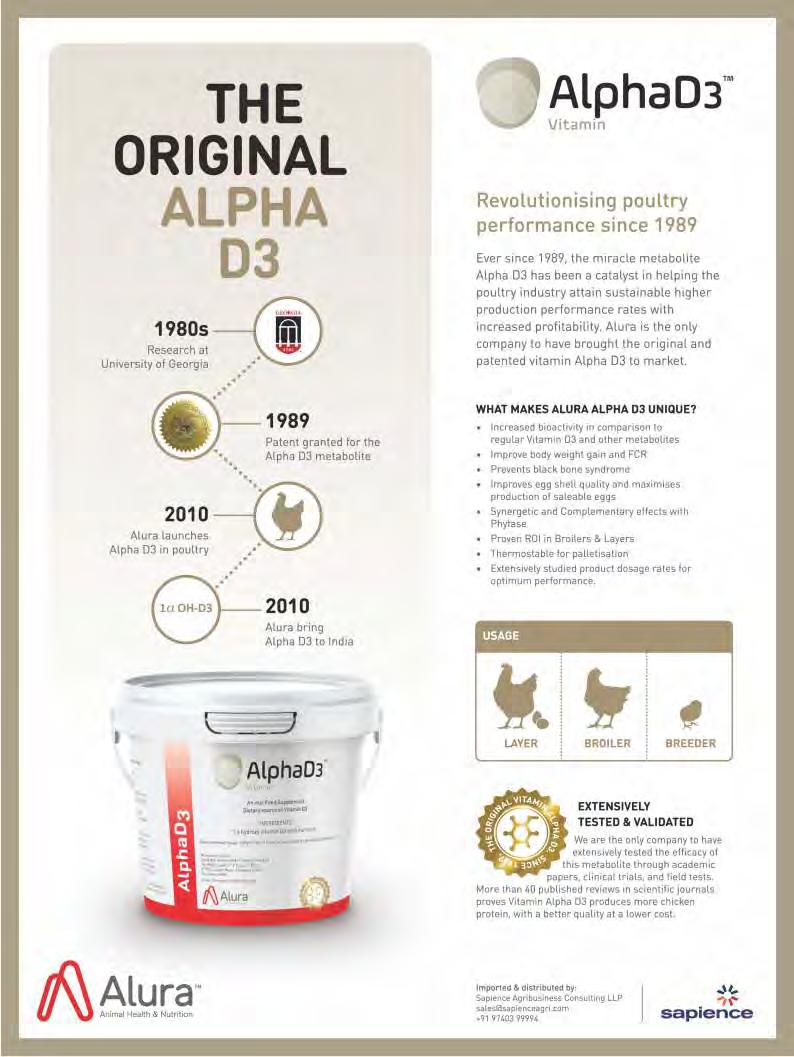
4 minute read
Natural Herbs


Advertisement


Vaccine handling and dilution
The drinking water used for vaccination can be stabilized by the addition of skim milk powder. It should be added at a rate of 2.0 – 5.0 g per liter of water or 2.0 – 5.0 liters of skimmed milk per 100 liters of water. Addition of the skim milk powder will form flakes which may block the pipelines. This can be prevented by stirring the water, so that all the powder is dissolved. The water should have optimum pH, but too high (>7,5) or too low (<6.0) pH will have negative effect on vaccine efficiency. Chlorine levels in drinking water as low as one ppm (1gram per 1000 lit of water) can even inactivate the vaccine. Effervescent tablets available in markets can be used to neutralize chlorine if the levels are higher. T h e w a t e r s h o u l d b e a t a temperature of around 15 degree celcius which can be maintained by adding ice cubes. Certain commercial products like VacSafe , Bluefarm contain chlorine neutralizer along with a water soluble blue dye. The dye when mixed with water changes the colour of water to blue, which can be used as an indicator of presence of vaccine water at the end of the drinker system. Further, these dyes mark the tongue, crop and feathers of the birds, in which the intensity of the color indicates the effectiveness of vaccination. Vaccines should be purchased from the authorized supplier, ensuring that the cold chain is maintained properly. The expiry date, vaccine strain and number of doses required can be checked. It can be transported as per the manufacturer's directions and kept at cold chain in the farm as soon as possible. Live vaccines are quite stable as long as they are in freeze dried form and stored in the refrigerator. On the day of vaccination, the vaccine vials should be prepared indoors and not in the floor of the entrance area of shed/ farm. Vaccine vials should be opened under water. Alternatively vaccine diluents can be injected into the vial to dissolve the vaccine. When opening vaccine vials, hands must be clean (free of sanitizer/soap residues) or use disposable gloves. When reconstituting vaccines it is better to use distilled water, or mains water that has been stabilized to neutralize chlorine.
Vaccine administration
1. The water supply should be turned off allowing the birds the drink the remaining water in the drinker line. 2. Raise the drinker line. Water deprivation should be done for about 60 minutes. Check the birds for the signs of excessive stress/ thirst 3. I n t h e m e a n t i m e , t h e unvaccinated water in the drinker line should be removed.
The line should be flushed with untreated water to remove the residues of chlorine, antibiotics, etc. 4. The drinkers can be then primed with vaccine water. Check that the vaccinated water in the head tank has reached the end of the line
5. Lower the drinker line and allow the birds to consume the vaccinated water within 2 h o u r s . E n c o u r a g e t h e movement of birds to the drinker s, monitor stress a n d c o n t i n u e d fl o w o f vaccine. 6. After 2 hours, turn on main w a t e r l i n e , c l e a n t h e equipments, dispose of the remaining dose properly and continue to monitor the birds.
Monitoring and Record keeping
A s a l r e a d y d e s c r i b e d t h e intensity of blue dye in the tounge can be used to monitor the drinking water vaccination. If vaccination has been done correctly, at least 90% of the tongues and crops will be colored blue. Further, the birds can also be checked for serum antibody levels. Proper records should be maintained with complete details of vaccination done.
Conclusion
Drinking water vaccination is one of the economical method of immunizing the birds which incur lower labor cost, minimal s t r e s s t o t h e b i r d s a n d stimulates mucosal immunity. I n c o n s i s te n c i e s of va c c i n e dosage and less number of birds covered can be effectively overcome by following standard vaccination protocols. r











